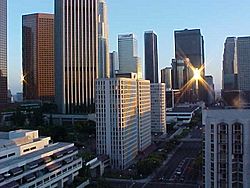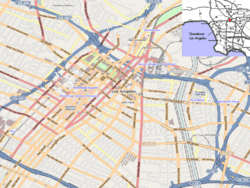Financial District, Los Angeles facts for kids
Quick facts for kids
Financial District
|
|
|---|---|

The Financial District as viewed from Bunker Hill
|
|
| Country | |
| State | |
| County | County of Los Angeles |
| City | |
| Area code(s) | 213 |
The Financial District (also called the Financial Core) is a very important part of Los Angeles. It's like the main business center of the city. This area is full of tall office buildings, hotels, banks, and businesses like law firms. It's a busy place where many people work.
The Financial District is located in Downtown Los Angeles. It has clear borders: the Harbor Freeway to the west, First Street to the north, and Main and Hill Streets to the east. To the south, it's bordered by Olympic Boulevard and 9th Street.
This district is near other interesting areas. It's south of Bunker Hill, west of the Historic Core, and north of South Park. It's also east of the Harbor Freeway and Central City West.
While Bunker Hill has mostly newer buildings from the 1960s onwards, the Financial District has some large, older buildings from the early 1900s. You can see many of these historic buildings along Seventh Street. This street used to be a fancy shopping area for the city. Today, the 7th and Flower area is a hub for the Metro rail system. It's also popular for its many restaurants, bars, and shopping centers.
Contents
A Look at the Financial District's Past
What we now call the Financial District was once farmland. Later, it became a neighborhood with single-family homes. Around 1900, as Downtown L.A. grew, businesses started moving into this area. They expanded south along Broadway and then west along Seventh Street.
Seventh Street: A Shopping Hotspot
Around 1915, Seventh Street became a very popular shopping area. It stretched from Broadway to Figueroa Street. This change began when a big department store called J. W. Robinson's built its main store on Seventh Street in 1915. This was quite far west from the existing shopping district on Broadway. Other famous stores like Ville de Paris and Coulter's also opened here. Many smaller, special shops joined them, making the area very exclusive.
However, this special status didn't last forever. In the late 1920s and through the 1940s, many upscale downtown stores opened branches in other parts of Los Angeles. A good example is the famous Bullock's store, which opened its Bullocks Wilshire branch in Mid-Wilshire in 1929. This meant that Seventh Street was no longer the only place for fancy shopping.
Growth of Office Buildings
Between 1920 and 1928, thirteen large office buildings were built in the area. By 1929, every piece of land on 7th Street between Figueroa and Los Angeles Streets had been developed. This shows how quickly the area grew into a business center.
Changes Over Time
The Financial District remained an important center for shops and offices throughout the 1950s. But it slowly started to decline in the 1980s. This was partly because many people moved to the suburbs. Also, much of Downtown's financial activity moved to Bunker Hill, just a few blocks north.
Big department stores like Bullock's (1983), Barker Brothers (1984), and Robinson's (1993) eventually closed. Only the Broadway/Macy's store at The Bloc, which used to be called Broadway Plaza, remained.
However, things started to change again. In 1986, the Seventh Market Place mall (now called FIGat7th) opened. This brought more shops back to Seventh Street. The 7th Street/Metro Center station also opened in 1991, making it easier for people to get to the area.
The Los Angeles Community Redevelopment Agency helped create the Financial District. Their goal was to offer a new business center. The older Spring Street Financial District had declined in the second half of the 20th century.
In 2010 and the years that followed, more and more people wanted to live in downtown Los Angeles. By 2015, thousands of new apartments were being built or planned around 8th Street. This shows the area is still growing and changing.
Getting Around the Financial District
The Financial District is well-connected by public transportation. The Los Angeles County Metropolitan Transportation Authority (known as Metro Rail and Metro Busway) provides subway, light rail, and local bus services. The LADOT also offers DASH and Commuter Express buses. These services help people travel throughout the Financial Core and to the wider Greater Los Angeles Area.
The 7th St/Metro Center station is a key transportation hub. From here, you can access several Metro lines: the B Line, D Line, A Line, and E Line.
Famous Buildings and Places
The Financial District is home to many well-known buildings and landmarks. Here are some of them, moving from west to east and north to south:
Fifth Street Landmarks
- Westin Bonaventure Hotel & Suites: This hotel is located between 4th, 5th, Figueroa, and Flower streets. It opened in 1976 and was designed by John C. Portman Jr.
- FourFortyFour South Flower: This tall building, once called Citigroup Center, has 48 floors and is 191 meters (627 feet) tall. It's at the northeast corner of 5th and Flower and opened in 1981.
- Richard J. Riordan Central Library (Los Angeles Public Library): This beautiful library is on the south side of 5th Street at Hope. It opened in 1926 and was designed by Bertram Grosvenor Goodhue.
- Millennium Biltmore Hotel: This historic hotel is on the south side of 5th Street, facing Pershing Square. It opened in 1923.
- Pershing Square: A large public park located between 5th, 6th, Hill, and Olive streets.
Sixth Street Landmarks
- Figueroa at Wilshire: This skyscraper, originally Sanwa Bank Plaza, has 53 stories and is 218.5 meters (717 feet) tall. It's at the southwest corner of 6th and Figueroa and opened in 1990.
- Pacific Financial Center: Located at the southwest corner of 6th and Flower. This 18-story building opened in 1973. It stands on the site of the former Southland Hotel, which was built in 1910 and torn down in 1971.
- Superior Oil Company Building (The Standard Hotel, Downtown Los Angeles): At the northeast corner of 6th and Flower, this building opened in 1956.
- 611 Place: Located at the northwest corner of 6th and Grand.
- PacMutual Building: Originally the Pacific Mutual Building, this building is at the northwest corner of 6th and Olive. It was built in stages between 1908 and 1936 and features beautiful Beaux-Arts and Moderne architecture.
- Aon Center: This very tall building has 67 floors and is 261.52 meters (858.0 feet) high. It's on the west side of Hope Street between 6th and Wilshire and opened in 1974.
- James Oviatt Building: This building used to be home to a men's clothing store called Alexander & Oviatt. It's located at 6th and Olive.
Seventh Street Landmarks
- Wilshire Grand Center: Also known as the Korean Air Tower, this is one of the tallest buildings in Los Angeles. It has 73 floors and is 335 meters (1,100 feet) tall. It takes up the entire block from Wilshire to 7th and from Figueroa to Francisco. It opened in 2017 on the site of the former Hotel Statler.
- Ernst & Young Plaza: This building has 41 floors and is 163 meters (534 feet) tall. It's at the southwest corner of 7th and Figueroa and opened in 1985.
- Fine Arts Building: Located near the northwest corner of 7th and Flower, this building opened in 1927.
- MCI Center: Originally called Broadway Plaza, this building has 33 floors and is 126 meters (414 feet) tall. It's at the southeast corner of 7th and Flower and opened in 1973. The Bloc shopping center is part of this complex.
- Brockman Building: Located at the southeast corner of 7th and Grand, this building opened in 1912.
- City National Plaza: Originally ARCO Plaza, this landmark has twin towers. It covers the entire block from 5th to 6th and from Flower to Figueroa. It opened in 1971.
- Los Angeles Athletic Club: This club is at the northeast corner of 7th and Olive and opened in 1912.
Eighth Street Landmarks
- 777 Tower: Originally Citicorp Plaza, this building has 52 stories. It's at the northwest corner of 8th and Figueroa and opened in 1991. Next to it is the FIGat7th shopping center, which opened in 1986.
- Southern California Gas Company Complex: This complex is at the southeast corner of 8th and Flower. The first part opened in 1925, and a six-story addition was completed in 1942.
Other Notable Places
- Jonathan Club: Another well-known club in the district.
Map of Buildings and Historic Sites
Landmarks are shown on the following street grid of the Financial District of Downtown Los Angeles.
Abbreviations and notes
- Abbreviations: DS=Department Store. res.=residential building
- Architectural styles: AD=Art Deco, BA=Beaux-Arts, BR=Baroque Revival, CR=Classical Revival, IRR=Italian Renaissance Revival, It=Italianate, Rom=Romanesque, RR=Renaissance Revival
- Architects: C&B=Curlett & Beelman, JP=John Parkison, P&B=Parkinson & Bergstrom, RBY=Robert Brown Young
- Italics indicate the building's current name or main tenant.
- Non-italics indicate a historic name or tenant of an existing building.
- *An asterisk indicates a demolished building.
| F I G U E R O A |
Westin Bonaventure Hotel & Suites | F L O W E R |
FourFortyFour South Flower | U.S. Bank Tower OUE Skyspace |
CalEdison DTLA (a.k.a. One Bunker Hill, 1931) | G R A N D |
Gas Company Tower | O L I V E |
Park Fifth Towers (2019, res.) Site of Hazard's Pavilion, Temple/Clune's/Philharmonic Auditorium |
|||||
| FIFTH STREET | ||||||||||||||
| City National Plaza (ex-ARCO Center) | Central Library | Millennium Biltmore Hotel | Pershing Square | |||||||||||
| Superior Oil Company Building | H O P E |
AT&T Center (Site of Savoy Hotel NW 6th/Grand) | PacMutual | |||||||||||
| SIXTH STREET | ||||||||||||||
| Figueroa at Wilshire | Aon Center | Lincoln Savings Bldg. (1955) now Library Court (res) | Milano Lofts (1925) | Douglas Oil Bldg. #3 | Heron Bldg. (1921, Dodd) | |||||||||
| WILSHIRE BL. | ||||||||||||||
| Wilshire Grand Center a.k.a. Korean Air Tower | Figueroa (Home Savingss) Tower | Fine Arts Building | Roosevelt Building, 7th Street/Metro Center subway |
Union Oil Bldg. (1923) | Quinby Bldg. (1926), Bronson Bldg. (The Collection) (1913) | Bank of Italy (1922), Brock and Co. Bldg. (1922) | Los Angeles Athletic Club (1912) | |||||||
| SEVENTH STREET | ||||||||||||||
| Ernst & Young Plaza, FIGat7th | Barker Bros. DS Bldg. | MCI Center (orig. Broadway Plaza), 7th Street/Metro Center subway |
J.W. Robinson's DS Bldg. | Brockman Building (1912, once home to Haggarty's DS) | Coulter's DS (later Myer Siegel, Dohrmann's, now The Mandel) | Ville de Paris DS, now L.A. Jewelry Mart (1917) | ||||||||
| 777 Tower | ||||||||||||||
| EIGHTH STREET | ||||||||||||||
| Southern California Gas Company Complex | 8th+Hope | |||||||||||||
Images for kids
-
J. W. Robinson's flagship store on Seventh Street at launch, 1915. Robinson's locating on 7th marked the beginning of the street as the upmarket downtown shopping district
-
City National Plaza, 5th to 6th, Flower to Figueroa
-
FourFortyFour South Flower, NE corner of 5th/Flower
-
Millennium Biltmore Hotel, west side of Pershing Square (S side of 5th from Olive to Grand)
-
Figueroa at Wilshire building, SW corner 6th/Figueroa
-
Superior Oil Company Building, NE corner 6th/Flower
-
Aon Center, W side of Hope from 6th to Wilshire
-
Ernst & Young Plaza, SW corner 7th/Figueroa
-
777 Tower at NW corner 8th/Figueroa
-
Fine Arts Building, N side of 7th, W of Flower
-
MCI Center (orig. Broadway Plaza), SE corner 7th/Flower
-
Wilshire Grand Center a.k.a. Korean Air Tower, SW corner Wilshire/Figueroa



























